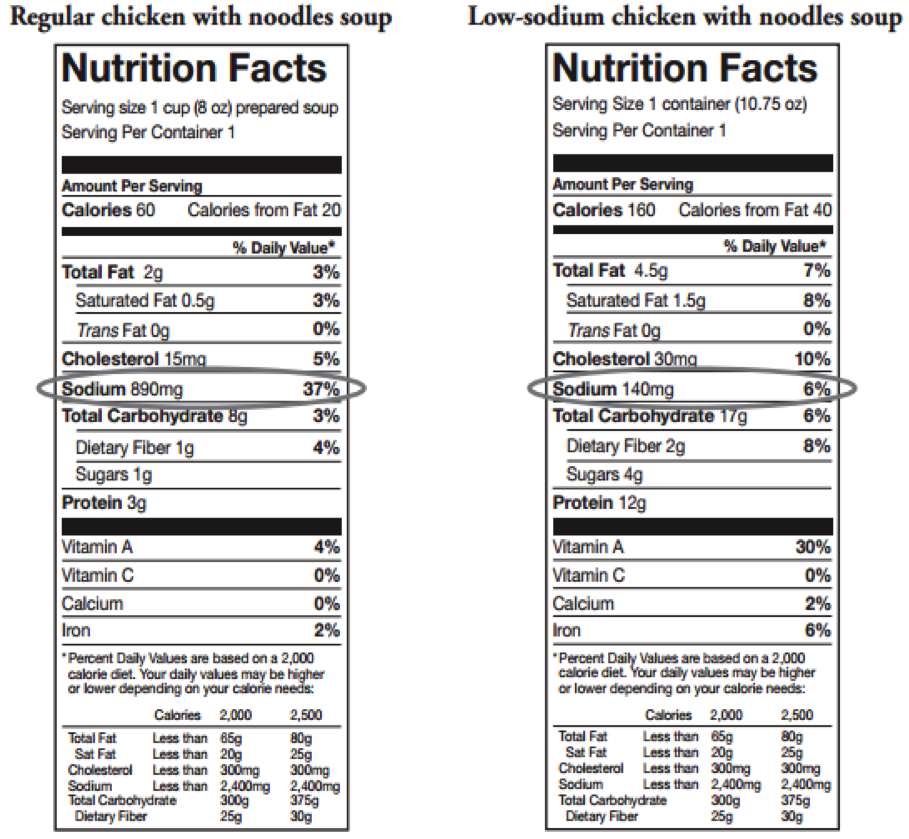The Skinny on Salt
Has your doctor ever told you to watch your sodium intake? Or cut out the salt in your diet? If so, then listen up and take note.
Sodium by definition is a ‘mineral’. It occurs naturally in foods (such as celery, beets, and milk) and is added to foods (such as canned foods, lunch meats, tv dinners) during processing in order to preserve the food.
Salt (table salt) by definition is made up of sodium and chloride. Salt is added to foods to preserve food, enhance color, or give food a firmer texture.
Since salt and sodium are in a majority of the foods we consume throughout the day, it is very easy to eat more than intended. Let’s take a look at some of the foods the National Kidney Foundation lists as high sodium foods.
High Sodium Sauces:
- BBQ sauce
- Steak sauce
- Soy sauce
- Teryaki sauce
- Oyster sauce
Other High Sodium Foods
- Sauerkraut
- Pickles, pickle relish
- Olives
- Buttermilk
- Cheese
- Soups
- Canned vegetables
- TV dinners
- Canned raviolis
- Mac & Cheese
- Spaghetti
- Frozen prepared foods
- Fast foods
High Sodium Snacks:
- Crackers
- Potato chips
- Corn chips
- Pretzels
- Tortilla chips
- Nuts
- Popcorn
- Sunflower seeds
High Sodium Meats
- Ham
- Salted Pork
- Bacon
- Hot dogs
- Cold cuts, deli meats
- Pastrami
- Sausage
- Corned beef
- Spam
Foods we may eat every day. (Yikes!)
So, do we even need salt/sodium?
The answer is Yes!
Sodium is a mineral that serves as an electrolyte in the body. Your body needs electrolytes to control blood pressure and blood volume. The balance of sodium and potassium (also an electrolyte) are necessary for excess fluid to be drawn out of the bloodstream, filtered through the kidneys, and removed as urine.
When excess sodium is present in the body it causes an imbalance in blood volume. This is because sodium attracts water leading to an increase in the volume of your blood, and consequently an increase in your blood pressure. The increase in blood pressure is due to the heart working harder to pump the high force of the blood flow. This can also cause increased work for the kidneys as they filter more in efforts to get rid of excess fluid.
The side effects of excess sodium long term can cause damage to the heart, kidneys, eyes, and brain.
How much sodium do you need?
According the American Heart Association, a person should NOT consume more than 2,300 milligrams (mg) of sodium a day, and ideally consume about 1,500 mg a day. Aim for no more than 350mg of sodium per serving or at each meal/snack.
How do you know if you are consuming a lot of sodium in a food item?
- Sodium free- means only a trace amount of sodium per serving
- Very Low Sodium- means 35mg sodium or less per serving
- Low Sodium- means 140mg or less per serving
- Reduced sodium- means the level of sodium is reduced by 25%
- Light or Lite in Sodium- means the level of sodium is reduced by at least 50%

Rule of Thumb: If salt is listed in the first 5 ingredients, then the item is probably too high in sodium to use.
Herb & Spice Recipe Tips!
● Dried basil is great for adding flavor to a low-sodium pasta sauce. You can also use it to season vegetables, fish, chicken, or lean meats.
● Dried or fresh thyme is especially tasty when used to season fish filets but it also goes great with any meat, poultry, bean, or egg dish. You can sprinkle it (along with a little bit of olive oil) over vegetables or potatoes before roasting them in the oven. It also pairs well with lemon.
● Cumin is a common spice used in many different cuisines. Use it along with some chili powder and garlic powder to season chicken, ground meat, or vegetables for fajitas or tacos. It can also be added to chilis, curries, or stews.
● Chili powder will add a kick to any dish. It’s actually a seasoning blend that includes dried chilis, garlic, oregano, and cumin. Add to it stews and chilis, or use it in meat and veggies for fajitas. In many instances, it is used in combination with cumin and/or paprika.
● Dried or fresh rosemary is a strong herb that can be sprinkled on fish, chicken, or meats before grilling or roasting. It is also tasty on roasted potatoes.
● Crushed red pepper flakes or ground red pepper such as cayenne will add heat to any dish. You don’t need a lot to add a kick. Use this in rubs, sauces, stews, and more.
● Cinnamon complements both sweet and savory dishes. Simply use it to top your toast or light yogurt, or stir it into your oatmeal with some toasted nuts. Use it in cooked fruit dishes to make a tasty and healthy dessert. It can also be added to stews and chilis in combination with other spices.
● Dried oregano is especially good in tomato-based dishes and is common in Italian cuisine. You can use it in soups or sprinkle it over vegetables before cooking. Try sprinkling it over pizza, pasta dishes, or garlic bread.
*When choosing spice mixes or dried herb mixes, make sure that they are salt-free. Store these in a cool dark place to maximize their shelf-life. Most of the time, you’ll want to use dried herbs toward the beginning of cooking so there is time for the flavor to release.